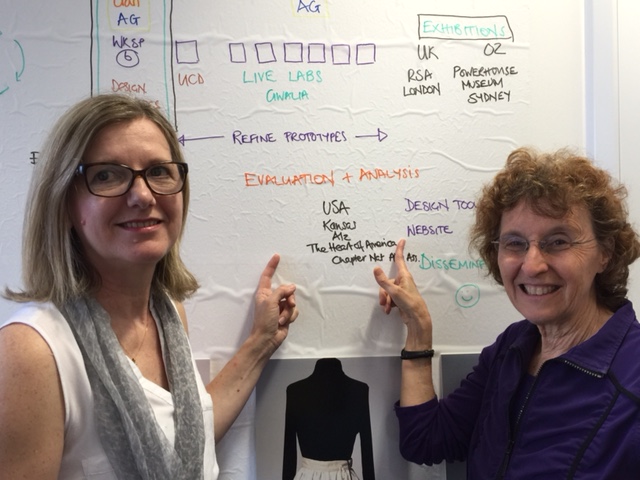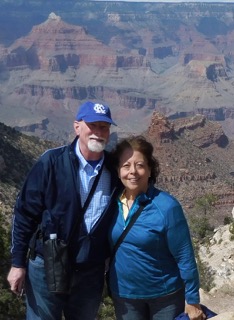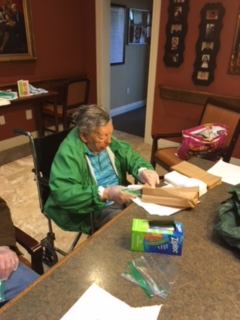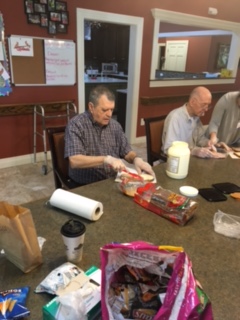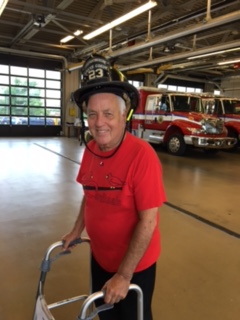Posts Tagged ‘Alzheimer’s Caregiving’
Orchestrating a Musical Conversation
When Ron’s dad was living in a memory care unit, Ron and I talked with the residents and their families, learning about their favorite songs. We orchestrated a sing-along and had fun working with everyone and putting together a scrapbook of each resident’s special tunes. The combination of music and conversation created a sense of community for us all. Julian West, who we met on a recent trip to London, is creating community through engaging people in music and dance. We really love the way he weaves the two art forms together and wanted to share his easy and adaptable ideas with you.
Julian West had no idea what would happen at the care facility, but he trusted it would be something wonderful. An accomplished oboist and a teacher at the Royal Academy of Music, Julian assembled a violist, a composer, a dancer, and an artist to share energy and their art with people who are living with dementia.
“This was an experiment to see what could happen,” Julian says. “We worked completely improvisationally.”
Once a week, for eight weeks, the troupe came to the residential care home and created a living arts experience with residents and staff. They began by inviting everyone to choose a percussion instrument, such as rain sticks, bells, shakers, tambourine, etc.
“We had a musical conversation,” Julian says. “One person made a sound and another answered. We also chatted a lot. People commented on the music or expressed an emotion or impression.”
The musicians added their instruments and the staff and residents joined in, through percussion and voice. They made fascinating sounds, like an improv jazz singer might do. The dancer twirled around in the center of their circle. Her free movements gave the group a focal point and inspired others to explore various movements.
“I let go of preconceptions and tried to create an open atmosphere,” Julian says.
The artists’ openness helped the “conversation” grow and blossom.
One woman who was living with dementia held up a tambourine, keeping it still and gazing at it as though it were a beautiful and revered object.
Julian’s first thought was, “She doesn’t know it’s a musical instrument”.
“I let that thought go,” he says. “I saw how expressive she was. Her interaction with the tambourine was beautiful and profound and she allowed us all to see the instrument differently.”
Even if you don’t have your own musicians and dancers at home, you can still create this supportive and creative atmosphere.
- Share a few percussion instruments, put on some music you both like, and make some joyful noises. Experiment with bee-bop syllables to add a sense of freedom.
- After the song, talk about the experience, what you liked, what you felt, and any other impressions that came up.
- Consider inviting a “guest dancer,” someone who likes to move to music, or a child of a friend who’s taking dancing lessons. Go ahead and add your own moves.
- Invite friends and family to join you. You’ll have something to laugh, and sing, and talk about.
For more information about Julian’s work, visit: www.julianwest.co.uk
Tips from a Parisian Artist
 There’s something magical about visiting an artist in his studio. Especially if that studio is in Paris. We were honored to meet Patrick Laurin, artist and art therapist, on a recent trip to France.
There’s something magical about visiting an artist in his studio. Especially if that studio is in Paris. We were honored to meet Patrick Laurin, artist and art therapist, on a recent trip to France.
In the beginning, Patrick Laurin’s work with people who were living with dementia went slowly. When he first visited the care home and invited people to join him for painting, he heard various reasons the idea wouldn’t work. “I can’t hear you.” “I can’t see you.” “I can’t move my arm.”
 Patrick, who had quit working as researcher in the pharmaceutical industry so he could create deeper connections with clients, understood the importance of building relationships. Gradually, he got to know the people who lived in the community. He wanted to tailor an artistic experience specific to each person’s abilities and needs.
Patrick, who had quit working as researcher in the pharmaceutical industry so he could create deeper connections with clients, understood the importance of building relationships. Gradually, he got to know the people who lived in the community. He wanted to tailor an artistic experience specific to each person’s abilities and needs.
Over time, the people who couldn’t see, hear, or move were all happily involved in painting.
One woman seemed to blossom when holding the brush and stroking on the paint. Even though she couldn’t later remember to say, “I’ve been painting,” she enjoyed the experience.
One day, Patrick was on another floor in the care community when he encountered this woman and her daughter.
Her daughter said to Patrick,” You are the painter.”
Patrick was thrilled her mother had been able to mention the art therapy sessions. But before he could respond, the mother said, “No, the painter is me.”
“Inside, she was seeing herself as an artist,” Patrick says. “The painting strengthened her identity.”
 Patrick has learned to approach each person with flexibility. Sometimes Patrick jump starts his artists with a squiggle of color on the page. Then he steps back to let them respond with their own squiggle. If they’re stymied, he offers a choice of two colors.
Patrick has learned to approach each person with flexibility. Sometimes Patrick jump starts his artists with a squiggle of color on the page. Then he steps back to let them respond with their own squiggle. If they’re stymied, he offers a choice of two colors.
He also uses collage techniques to inspire his artists. He selects three separate pictures, each with one recognizable thing, such as a house, tree, or dog. He shows the photos to the artist, and asks, “Which one of these attracts you?” When the artist chooses a photo, Patrick then asks, “Where would you like to put this on the paper?” He and the artist apply paste to the paper.
“We don’t turn over the picture and apply paste, because the image then disappears and that can be confusing,” he says.
When the picture is glued to the paper, Patrick discusses a color that’s already in the picture.
“You could take the blue in the sky and extend it,” he might suggest. This suggestion often inspires the artists to start painting. If they get stuck, Patrick says, “What might look good near the house?” In this way, the painting expands.
For one woman, painting began as a series of colors and grew into a personal story.
She pasted a house and began expanding the lawn. Then she drew a bridge and weeks later, she added in a dog. At first, she was painting “a house, a bridge and a dog.” As the picture took shape, she said, “This is my house and my dog and this is the bridge we had to cross to get to the house.” The process of painting had loosened memories of her childhood home.
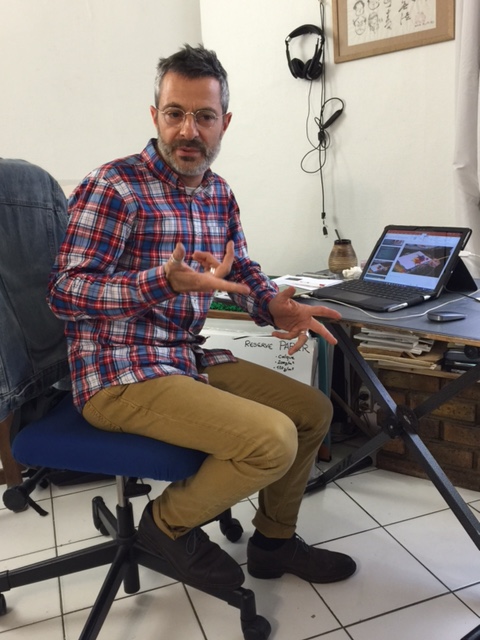 “When I share a piece of art by one of my students, I also share the story behind it,” Patrick says. “The act of creation is more important than the results.”
“When I share a piece of art by one of my students, I also share the story behind it,” Patrick says. “The act of creation is more important than the results.”
Tips:
Pick something that is easy for you, the care partner.
Put a point of color on the pages, then stand back. Offer support but don’t paint.
Enjoy the process and don’t get stuck on the results.
Thanks to Berna Huebner, founder of the Hilgos Foundation and co-producer of the documentary, “I Remember Better When I Paint,” for suggesting we meet with Patrick.
Three Top Tips for Tuning into Singing: Insights from Finland
Mom was staring into space, oblivious to my brilliant smiles and cheerful conversation. So I started to sing, just to occupy myself. I chose songs Mom liked, such as “Oh What a Beautiful Morning,” “A Summer Place,” and “You are My Sunshine.” Normally, I felt a little down when I didn’t really get to connect with Mom during my visits. But after a half-hour of being a one-woman show, I felt uplifted and energized. And Mom seemed to be making a sound much like humming.
Singing was often a part of my time with Mom. I’ve always felt happy after “making a joyful noise.” Now a study from Dr. Teppo Sarkamo and his colleagues in Helsinki, Finland, explains why.
Dr. Sarkamo’s research found that “regular musical activities can have an important role in maintaining cognitive ability, enhancing mood and quality of life” for people living with mild to moderate dementia. These activities also promote the well being of care partners and offer a beneficial leisure activity for the person living with dementia and the care partner.
Invite Out Your Inner “American Idol”
You don’t need special musical abilities to benefit from listening to music or singing. The research shows that incorporating simple musical activities in daily care is “a cost-efficient way for offering emotionally, cognitively stimulating, and enriching musical experiences.”
The study’s music therapist, Sari Laitinen, kindly offered these ideas for care partners and the person living with dementia.
- First, reserve enough time together to spend with the music. The main thing is feeling peaceful together. When singing, choose the songs together from a songbook. In our research project, we prepared a song booklet of our own for the participants, which mostly included well-known Finnish singe-a-long songs from their early years: childhood, teenage years and early adulthood. The care partner can begin by humming a melody first, and if their partner recognizes the song, they can start singing it together. Usually, the partner knows the lyrics “by heart” and their memory retrieval is quite automatic.
- Usually the songs bring about personal, autobiographical memories related to the life era and events when the songs were popular. Allow the reminiscence of your partner to proceed on its own time and terms, accepting the stories and not immediately correcting if the people or places happen to be incorrect. You want a mutual feeling of telling each other important things about life. It is all about acceptance and the understanding that something important is shared. The feeling of being understood helps to cope with life.
- Listening to music is based on the same principles as singing together: the care partner can suggest some records he/she thinks are meaningful and see what happens. When asking your partner to choose the record, it is good to have some LPs or CDs with a photo of the artist on the cover. Again, it is nice to have a quiet place for the listening and time to share the stories and the feelings that the music evokes. It is good to keep in mind that although the songs are familiar from a long time ago, the experience of music is always “here and now”. By experiencing the music together and by being sensitive to the ”reactions” (emotions, thoughts, memories) evoked by the music, the care partner can offer acceptance and validation of the experiences, the feeling of being understood. Given time, this can lead the discussion from the reminiscence of old times to themes that are important now, such as acceptance of the lived life, mourning of losses, joy in the moment, feeling of vitality, strengthening the feeling of life and so on.
For more information, visit: Singing is beneficial for memory and mood especially in early dementia
Clinical and Demographic Factors Associated with the Cognitive and Emotional Efficacy of Regular Musical Activities in Dementia, Teppo Sarkamo, Sari Laitinenb, Ava Numminenc, Merja Kurkib, Julene K. Johnson, and Pekka Rantanene a,
The Inside Story of Designing for Dementia
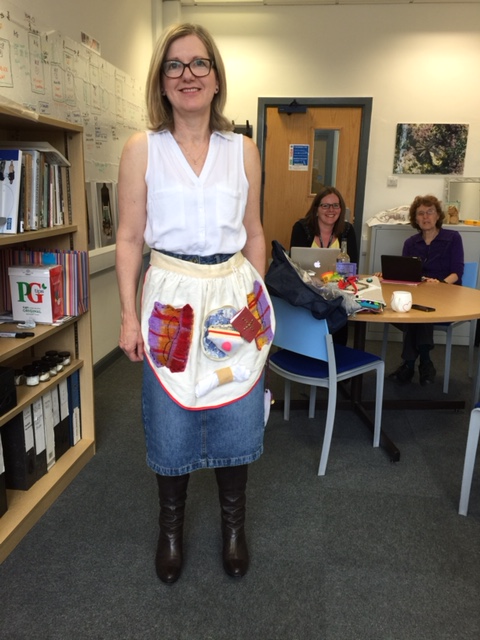 I love being around visionaries and Cathy Treadaway, PhD, is certainly one of them, changing the world one playful textile at a time. Cathy is the Professor of Creative Practice at the Cardiff School of Art and Design, Cardiff Metropolitan University, Wales, United Kingdom and she contributed to my upcoming book, Connecting in the land of Dementia: Creative Activities to Explore Together. I recently visited her at her university office in Cardiff, Wales, and wanted to share a few of her successes with you. In these stories, you’ll find intriguing ideas you can adapt to your own situation.
I love being around visionaries and Cathy Treadaway, PhD, is certainly one of them, changing the world one playful textile at a time. Cathy is the Professor of Creative Practice at the Cardiff School of Art and Design, Cardiff Metropolitan University, Wales, United Kingdom and she contributed to my upcoming book, Connecting in the land of Dementia: Creative Activities to Explore Together. I recently visited her at her university office in Cardiff, Wales, and wanted to share a few of her successes with you. In these stories, you’ll find intriguing ideas you can adapt to your own situation.
Walking in the Park Without Leaving Home
They often visited the park, walking the paths hand-in-hand, admiring the flowers and foliage, listening to the birdsong, enjoying the breeze and the fresh air. But as his dementia progressed, he could no longer navigate the park. Until Cathy Treadaway and her team created a tactile textile replica of the park, complete with interactive technology. When he pressed one of the tree icons, he heard the sound of the wind. He pressed another and was rewarded with birdsong. Now, they sit together and he traces the cloth paths and creates the sound effects as she talks about the outdoors and reminisces about their times together.
For Cathy Treadaway, that’s what her work is all about: enhancing life and keeping people connected. She specializes in creating individualized “playful objects,” interactive textiles that mirror the person’s interests and passions.
When Cathy asked about one person’s special interests, a favorite pet, a Westie, came up again and again. Cathy and her team set to work, building an apron that featured a soft white Westie that barked when pressed. The team velcroed the dog onto an apron. The woman living with dementia was fascinated by the apron and by the texture and sounds of the dog. So was her two-year-old great granddaughter. The apron gave her focus and pleasure and also offered conversation points for her multigenerational family.
Making Visits Meaningful
“Sometimes visiting someone is hard,” Cathy says. “These individualized blankets and aprons can make the experience easier and more fun for all parties.”
Cathy’s work is focused on compassionate design, using textiles as a means for retaining and building relationships. She often asks people this question: “If you could design something to strengthen the relationship between yourself and someone living with dementia, what would you design?”
For more information about Professor Treadaway and her work, please visit www.cathytreadaway.com and www.laughproject.info
Deborah Shouse is the author of Love in the Land of Dementia: Finding Hope in the Caregiver’s Journey.
COMING SOON: Connecting in the Land of Dementia: Creative Activities to Explore Together
Fulfilling the Bucket List, Trip by Trip
Our friends Elizabeth and Charlie Miller are a constant source of inspiration. Here is one of the many ways they embrace life.
Elizabeth and Charlie knew they had to instantly work on their travel bucket list. When they met and fell in love, Charlie had been living with dementia for four years. He had not traveled much, but he wanted to see the world with Elizabeth. He asked a friend to help him plan a romantic trip to San Francisco, where he proposed to her.
After she said, “Yes,” they combined their love of beaches and nature and began adventuring, going on driving trips, taking cruises, and sharing a multitude of experiences. When flying grew too complicated and stressful for Charlie, they focused on local day trips or short driving trips.
“I used to have to travel alone,” Elizabeth says. “Now, I travel with Charlie. He enjoys the trip in-the-moment. How wonderful to have all these shared experiences. Plus, it’s renewing to be outside of our routine.”
 Recently, Elizabeth and Charlie were driving around and Charlie said, “What was that long cruise last fall that had so many beautiful places?”
Recently, Elizabeth and Charlie were driving around and Charlie said, “What was that long cruise last fall that had so many beautiful places?”
Elizabeth stopped to think. “Hawaii,” she said.
“Hawaii,” Charlie said, his eyes bright. “Wasn’t that the best cruise ever?”
Elizabeth smiled and felt a deep sense of happiness and connection. “You are right. It was the best cruise ever.”
To make every trip “the best” here are a few flying travel tips from Elizabeth:
- Try for a non-stop flight at a time best for the person living with dementia.
- Call TSA in advance and arrange for assistance in getting through screening.
- Ask for a Pre-boarding pass to minimize the stress in boarding.
- Get a business-type card that says, “Thank you for your patience with my companion. He is living with dementia.” Share this information, as needed.
- Carry a travel packet that includes a letter from an MD, stating that your companion has dementia, and a medical power of attorney. Include doctors’ names and contact information as well as emergency contact information.
- Carry a bag of essentials: water, snacks, medications, a change of clothing, and activities.
- Be flexible, in the flow, and have fun!
Get Cooking on Giving Back
The assembly line stretched around the spacious dining room table and each person focused fully on his task. One man spread mayonnaise on bread. Another placed turkey slices and another added cheese. Another slipped the sandwich into a baggie and others assembled the lunches, adding potato chips and a cookie. All worked diligently; there was a special purpose to this meeting of the Men’s Club at Dolan Memory Care Homes in Creve Coeur, Missouri. They were giving these homemade meals to the fire fighters in their community as a way of showing their appreciation.
Ten residents of varying abilities, including all levels of memory impairment, contributed to the sandwich brigade. Those who needed help had an assistant with them.
“The participating residents were filled with high energy and good spirits,” says Mary Kate Halm, LMSW, Admissions Coordinator of Dolan, who organized the activity. “They were excited to be engaged.”
The local fire department had invited the group to tour the station when they delivered the lunches. The experience included opening up the sides of the fire truck. One of the residents, who was usually indifferent to outings, used to be a tool designer. When he saw the tools in the fire truck, his eyes grew wide and he became very animated.
“Everyone enjoyed being engaged in a purposeful activity. They loved the tour and they asked excellent questions,” Mary Kate says. They wanted to know the details of their training, how much each truck cost, how much their equipment weighed, and more. The residents weren’t the only ones engaged.
“The firemen loved the attention,” Mary Kate says. “Plus, they were patient, communicated clearly, and were considerate of those in walkers and wheelchairs.”
The community volunteer activity generated a lot of joy and curiosity.
“They were completely connected to the experience,” Mary Kate says. “They were learning, they were giving back, and they were fully present. We created a moment of joy and that’s all that matters.”
Get ready to give back:
Mary Kate offers these tips for connecting with the community and giving back.
- Look for a service organization that you admire. This can be emergency responders such as fire fighters, police, sheriffs, EMTs, as well as animal rescue teams, cancer support organizations, and more.
- Find a project that’s fun for you and for the person living with dementia, a project you can both participate in. If you have friends and family who’d like to help, this is a great time to get others involved.
- Coordinate with the organization and find a time to deliver your gifts. If it’s of interest, ask for a chance to learn more about the organization.
For more interesting activity ideas, visit https://t.e2ma.net/message/gxreo/4bbql
Music Matters in the Land of Dementia
How can creating a personal playlist, listening to favorite tunes, singing simple melodies, and pretending to conduct a symphony improve your life? Come to this free workshop and find out.
Music Matters in the Land of Dementia (and Everywhere!) An Interactive Program for Family Friends, Professional Care Partners, Activity Professionals, Musicians, and More
 In this lively one-hour session, coming up on July 20, we will share ideas for using music to deepen connections with people who are living with dementia. Some of these ideas, gleaned from top innovators and researchers, are from my upcoming book, Connecting in the Land of Dementia: Creative Activities to Explore Together. According to numerous studies, music improves the lives of those living with dementia by reducing the need for psychotropic drugs, increasing socialization, and relieving depression. The event is going to be joyful and fun and we’d love to experience it with you.
In this lively one-hour session, coming up on July 20, we will share ideas for using music to deepen connections with people who are living with dementia. Some of these ideas, gleaned from top innovators and researchers, are from my upcoming book, Connecting in the Land of Dementia: Creative Activities to Explore Together. According to numerous studies, music improves the lives of those living with dementia by reducing the need for psychotropic drugs, increasing socialization, and relieving depression. The event is going to be joyful and fun and we’d love to experience it with you.
Here’s the workshop information:
Deepen your connections, increase communications, and ratchet up your fun quotient by adding music into your caregiving journey. Authors and dementia advocates Ron Zoglin and Deborah Shouse team up with guitarist Rod Fleeman and singer Cynthia Schroer for this hands-on session. They’ll share easy music-oriented ideas that can soothe anxieties and unlock creativity in people who are living with dementia, as well as splash notes of joy and renewal into the care partners’ lives.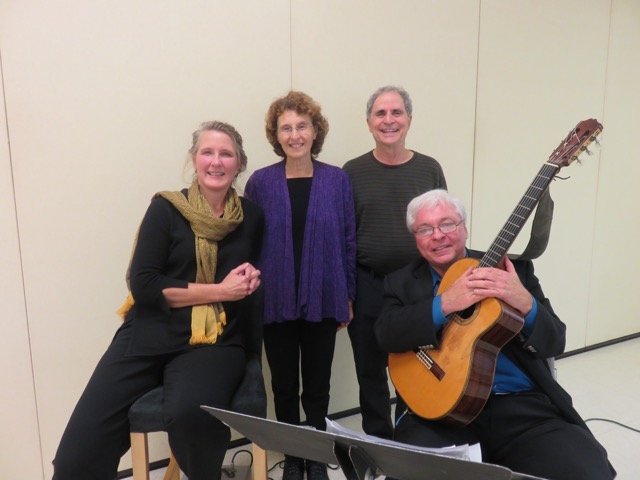
We are partnering with Shalom University to present this free session on July 20th from 10:00 to 11:00 at Village Shalom, at corner of 123rd and Nall, 5500 W 123rd Street, OP 66209. To sign up for this musical experience, just call Bree at (913) 266-8469 or email vsu@villageshalom.org as soon as possible.
Victor Hugo said it so beautifully: Music expresses that which cannot be put into words and that which cannot remain silent.
Music Matters
 During my mom’s dementia journey, music often inspired and connected us. Here is one of those melodic moments, excerpted from my book, Love in the land of Dementia: Finding Hope in the Caregiver’s Journey. The story is set in my mom’s memory care community.
During my mom’s dementia journey, music often inspired and connected us. Here is one of those melodic moments, excerpted from my book, Love in the land of Dementia: Finding Hope in the Caregiver’s Journey. The story is set in my mom’s memory care community.
Rochelle, the activity director, sticks in another tape and soon Stardust is playing.
“Let’s dance,” she says, motioning everyone to stand.
Mom looks up and I offer her my hand.
“Want to dance?” I ask her.
“What?”
“Want to dance?” I repeat, making a swirling motion.
“What else,” she says, standing up.
My parents have danced to this song many times, my mother coaxing my father onto the dance floor. I hold hands with Mom and move back and forth to the music. She laughs and does the same. I twirl her, and she walks around in a jaunty little circle. For a moment, her energy and charm have returned. I feel like I have found my long-lost mother. If my father were here, he would not be surprised. He is certain she will return to him and takes every word, every gesture of affection, every smile as a sign of hope.
“Hope is everything,” Dad told me just last week. “I find something hopeful and I milk it for all it’s worth. If it doesn’t work out, then I search for something else. Otherwise, I am in despair.”
I twirl my mom again. It is actually our first real dance together…
Deborah Shouse is the author of Love in the Land of Dementia: Finding Hope in the Caregiver’s Journey.
COMING SOON: CONNECTING IN THE LAND OF DEMENTIA: CREATIVE ACTIVITIES TO EXPLORE TOGETHER
How to Create a Network of Dementia Friends
Ron and I recently traveled to Europe and we were lucky to meet with several creative thought leaders working in the field of dementia. Over the next weeks, we’ll share some of their insights with you, ideas we can incorporate into our every day lives as care partners, friends, and dementia advocates. We met with Philippa Tree, Senior International Officer Alzheimer’s Society UK, in a charming coffee shop located near the Tower of London.
The U.K. has more than one and a half million Dementia Friends, and 10,000 Dementia Friends Champions, volunteers who deliver the Information Sessions. Their goal–four million Dementia Friends in the next two years.
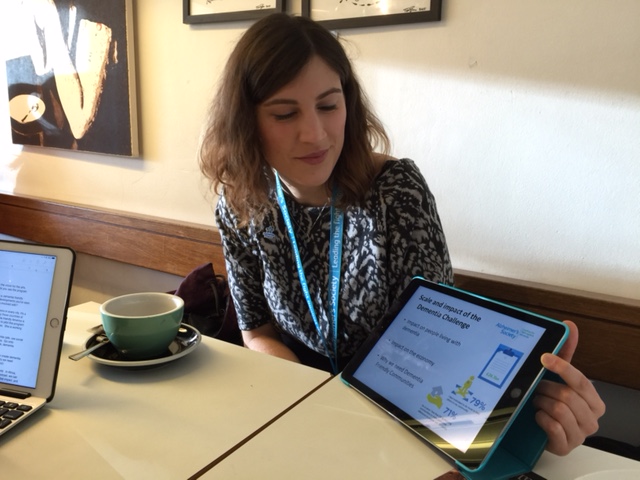 Philippa Tree is part of the Dementia Friends team at Alzheimer’s Society UK. The Dementia Friends programme is a social action movement that aims to transform the way England and Wales think, act, and talk about dementia. It started in 2012 when the Prime Minister of the United Kingdom, in partnership with Alzheimer’s Society UK, urged his country to focus on building dementia-friendly communities. He became a Dementia Friend and challenged others to join him.
Philippa Tree is part of the Dementia Friends team at Alzheimer’s Society UK. The Dementia Friends programme is a social action movement that aims to transform the way England and Wales think, act, and talk about dementia. It started in 2012 when the Prime Minister of the United Kingdom, in partnership with Alzheimer’s Society UK, urged his country to focus on building dementia-friendly communities. He became a Dementia Friend and challenged others to join him.
The free Dementia Friends Information Sessions help people understand what living with dementia might be like. The sessions also offer small action steps so people can make a difference to those affected by dementia in their community. Anyone of any age can be a Friend by attending an information session or watching an online video.
Philippa’s work with Dementia Friends extends beyond the UK and across the world. She’s recently been collaborating with partners in the United States to roll out a pilot Dementia Friends program in the near future. At the recent Alzheimer’s Disease International Conference in Budapest, Philippa facilitated a session with countries including Nigeria, Germany, Israel, Scotland, Canada, and Indonesia.
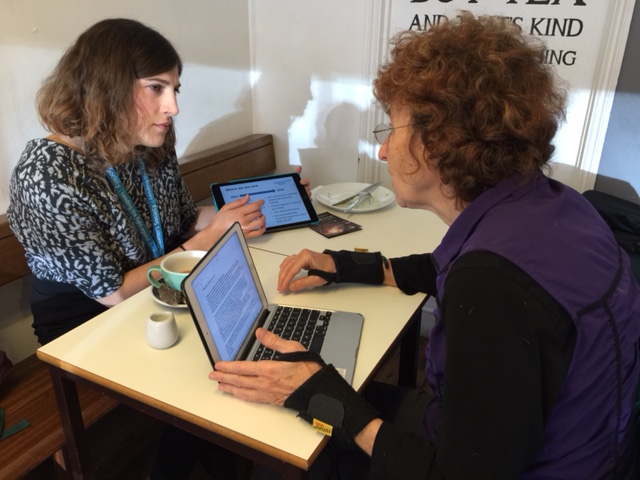 “After only two years, Dementia Friends has become one of the UK’s biggest social movements on any disease.” Philippa says. “We’re working on using positive language and spreading positive messages as we tackle the stigma around dementia. My current role is to support countries worldwide to implement a Dementia Friends program, and to learn and share experiences.”
“After only two years, Dementia Friends has become one of the UK’s biggest social movements on any disease.” Philippa says. “We’re working on using positive language and spreading positive messages as we tackle the stigma around dementia. My current role is to support countries worldwide to implement a Dementia Friends program, and to learn and share experiences.”
While Philippa and her team are working in England and Wales, and worldwide, each of us can make a difference on a local level. Here are examples of action steps people have enjoyed taking:
- Share positive stories about friends and family who are living with dementia. This helps reduce the social stigma.
- Volunteer for creative programs and events for those who are living with dementia.
- Spend time visiting family and friends who are living with dementia.
- Talk to other care partners and ask how their lives are enriched through their caring experiences.
For more information about the Dementia Friends programme, please visit their website : www.dementiafriends.org.uk.
Deborah Shouse is the author of Love in the Land of Dementia: Finding Hope in the Caregiver’s Journey.
COMING SOON: CONNECTING IN THE LAND OF DEMENTIA: CREATIVE ACTIVITIES TO EXPLORE TOGETHER
A Unique Opportunity to Learn from Creative Pioneers
I just received this webinar invitation from Garuth Chalfont, who is a pioneer in using nature with those who are living with dementia. I interviewed Garuth for my upcoming book and he is filled with great ideas. I am going to attend his free webinar and I thought it could be of interest to you. Please feel free to share this with others. It’s a unique opportunity to learn from innovators in this creative field.
www.lancaster.ac.uk/fhm/research/centre-for-ageing-research/#newsampevents Click on the link and simply scroll down to “Non-drug Treatments to Intervene and Prevent Dementia.” To register, email Jan and she will put you on the list.
Meanwhile, these tips from Garuth are featured in Connecting in the Land of Dementia: Creative Activities to Explore Together, which comes out in September.
“Research shows that nature-based activity is therapeutic and is essentially a form of treatment for dementia symptoms, helping a person remain at home longer,” says Garuth Chalfont PhD, American Society of Landscape Architects, and author of the Dementia Green Care Handbook. (You can download this book for free by going to Garuth’s website: www.chalfontdesign.com/ Garuth is internationally known for his work in designing, building and researching gardens that benefit people with dementia. He also partners with care facilities and families, helping them integrate nature into their living quarters and their outdoors.
Gathering flowers, walking a tree-lined sidewalk, plucking a cherry tomato off its vine, watering a house plant, gazing out the window at chickadees—these meaningful natural activities increase pleasure, relaxation, social interactions, and sensory stimulation.
“Enjoying the garden goes beyond just walking around,” Garuth says.
Imagine you’re hosting a guided tour of your yard. What is the most thrilling part of your lawn? A blooming rose bush? A bird bath? A wise old fir tree?
“By creating a tour, you’re taking a new look at your environment. You’re telling a story and engaging your partner,” Garuth says.
Stir up conversation by focusing on one area at a time. Perhaps discuss the hanging bird feeder. Or a seashell you two found on your last vacation. Then observe the birdbath or other water feature. Do you have a bench? Sit down and talk about what you see. Create a wow ending with something that is fun and dramatic, such as a ceramic gnome peeking from behind a rock. Seeing your yard as a living story may inspire you to add in a playful spinner, a cute stone animal, or a beautiful rock.
Deborah Shouse is the author of Love in the Land of Dementia: Finding Hope in the Caregiver’s Journey.
COMING SOON: CONNECTING IN THE LAND OF DEMENTIA: CREATIVE ACTIVITIES TO EXPLORE TOGETHER
Dementia Café: Connecting through Donuts and Baseball
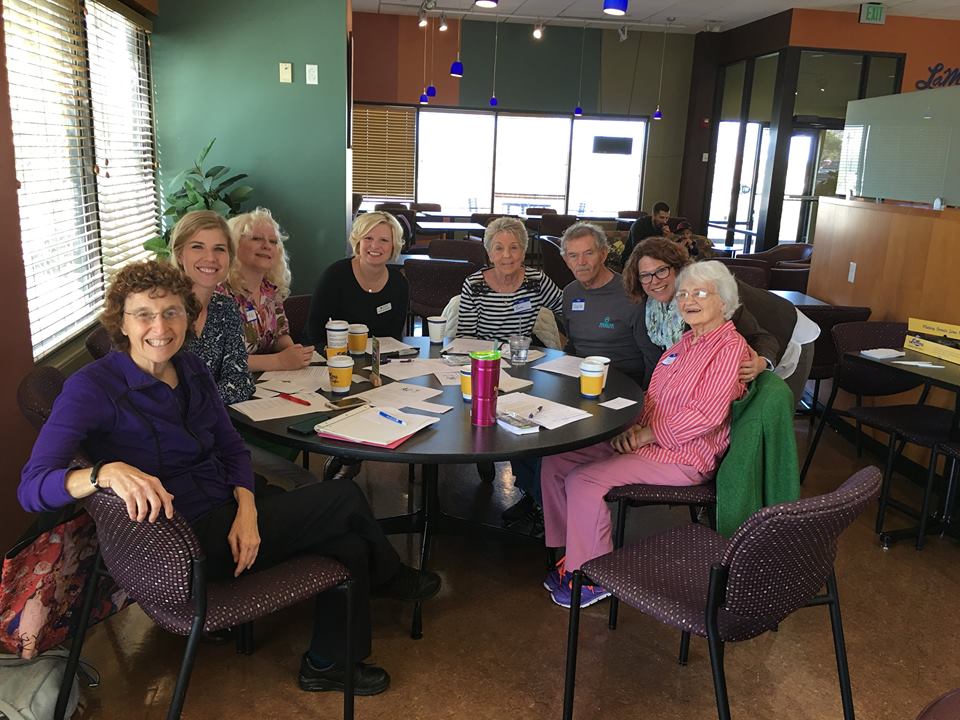
I’ve always enjoyed gatherings of creative people, so I was excited when I learned that Mandy Shoemaker was orchestrating a Dementia Café in our area. The premise is simple and fun: a group of people living with dementia, their care partners, and friends get together in a public space for a facilitated time of conversation, sharing, and creativity.
Mandy’s café took place in Lamar’s, a locally esteemed donut shop with a quiet atmosphere and a spacious seating area. Eight of us gathered around a table and Mandy opened the conversation by showing us a black and white photo of a baseball player laying on a field, next to a fence, apparently knocked out.
“Babe Ruth,” she told us. “He was running backwards to catch a ball and crashed into the barrier.”
We all nodded in sympathy, then began sharing baseball stories. Charlie had played in his youth and he and his wife Barb were ardent Royals fans. Courtney had played softball in high school. Fran, who grew up in the 1930’s in rural Mississippi, never had a chance to play sports but she liked hearing about the game.
“Did you ever listen to baseball on the radio?” Mandy asked her.
“In those days, not everyone had everything,” Fran said. “I don’t think we even had a radio.”
Barb remembered being on her grandparent’s farm, huddled around the radio, listening to the Yankee’s games.
“Have you ever heard the poem Casey at the Bat?” Mandy asked.
“I memorized it at school,” Charlie said.
 We took turns reading the dramatic poem, discussing such vivid terms as “when the dust had lifted” and “Casey lightly doffed his hat,” and one ball player was a “lulu” while another was “a cake.” The tension built and we chanted the last verse together. (Seek out this poem if you want to know what happened in Mudville that day: www.baseball-almanac.com/poetry/po_case.shtml )
We took turns reading the dramatic poem, discussing such vivid terms as “when the dust had lifted” and “Casey lightly doffed his hat,” and one ball player was a “lulu” while another was “a cake.” The tension built and we chanted the last verse together. (Seek out this poem if you want to know what happened in Mudville that day: www.baseball-almanac.com/poetry/po_case.shtml )
We then created a group poem, each contributing an answer to “Baseball is…”
I left the café feeling exhilarated and connected. Baseball was a catalyst for a great conversation that included life in the 1930s, family origins, Memphis, Elvis, baseball cards, Abbott and Costello, poetry, women and sports, fathers, hard work, radio programs, and more.
“It is our goal to create a more dementia-friendly community,” Mandy says. “Part of that is creating safe places for people with dementia to come and be a part of a group, with no expectations. The café invites people to just get out, be creative, and have fun.”
The KC Memory Café will meet on the second Tuesday of each month. To keep up to date, follow our facebook page at www.facebook.com/KCMemoryCafe
Create Your Own Cafe
You can also create your own café for two or more. Here are a few tips:
Select a public meeting place that serves refreshments and is reasonably quiet.
Let go of expectations and create a supportive atmosphere. You are here to express yourselves and connect.
Pick a broad topic that you are both interested in. Examples include seasons, sports, nature, games.
Start with a visual stimulation, such as a photo. Ask open-ended questions that invite imagination, such as “What do you see in this picture?” or “What do you think is going on?”
Allow the conversation to flow. The topic is a mere catalyst for ideas and communication.
Print out a familiar poem to read together. Enjoy the drama of reading aloud and invite comments on the poem.
For more about starting a café, visit
http://www.alzheimerscafe.com/public.html.alzheimersatoz.com/Welcome.html
Deborah Shouse is the author of Love in the Land of Dementia: Finding Hope in the Caregiver’s Journey.
COMING SOON: CONNECTING IN THE LAND OF DEMENTIA: CREATIVE ACTIVITIES TO EXPLORE TOGETHER



